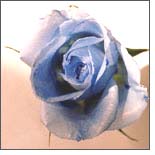The Straits Times, 4 September 2004
Pansy gene adds colour to blue roses
How are blue roses produced?
 FLOWER colour is largely due to the presence of a class of organic compounds known as anthocyanins (from the Greek words anthos for flower, and kyanos for dark blue). FLOWER colour is largely due to the presence of a class of organic compounds known as anthocyanins (from the Greek words anthos for flower, and kyanos for dark blue).
Each compound has a certain colour, named after the flowers they were first isolated from.
The final colour of flowers may vary depending on the mixture of several of the colour compounds.
Thus, red petunias will have mostly red pigments, while the blue and purple varieties have mostly the purple petunidin and very little of the scarlet red pelargonidin.
Some plants, such as carrots, tomatoes and cucumbers, also get the colours for their roots, fruits or flowers from another class of compounds, called the carotenoids, which our body makes into vitamin A.
The genes for the production of anthocyanins have been cloned and studied. In the rose plant, the gene that makes the blue pigment, delphinidin, is not functional, hence the lack of true-blue roses.
For a long time, breeders have been trying to grow blue roses by crossing varieties from around the world.
Although it is claimed that there are some blue roses in the market, varieties that have the blue pigment in their petals have not yet been produced.
Since 1990, an Australian company called Florigene, owned by Japanese group Suntory, has been working on the development of blue roses.
It is trying to clone the genes for blue pigments from other plants such as petunia and pansies, and introduce these genes into roses and carnations by genetic-engineering.
From such efforts, the world's first blue carnations - named Moondust - were produced in 1995.
They have been marketed since 1997 in Japan and Australia.
In June this year, Suntory unveiled the world's first 'blue rose' made by genetic-engineering.
It carries a gene from the pansy plant that makes the blue pigment, delphinidin.
Although the present variety is purplish-blue, the scientists are confident that they can generate a 'true-blue rose' variety in the next several years.
Dr Prakash Kumar
Associate Professor & Deputy Head
Department of Biological Sciences
National University of Singapore
Note: This is a weekly series run The Straits Times where experts help unravel the mysteries of the universe. Questions can be sent to stlocal@sph.com.sg
Singapore Press Holdings Limited The Straits Times (Singapore).Copyright 2004
|